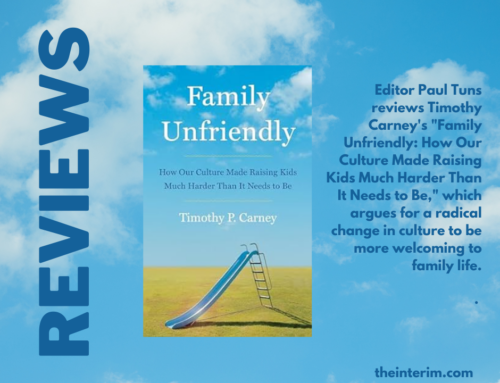 For years The Interim has carried stories about sex-selective abortions and female feticide. In 1992, we ran an article about a woman who was doing sidewalk counselling in Calgary who was able to talk to a would-be mother of East Indian descent. She did not want to have an abortion but her partner did – after they found out that their child was a girl. The counsellor wrote of the mother: “She was first a victim of a culture that places more value on male children, and she was likely powerless to defy her husband’s will.” Since then we have carried dozens of articles warning that a woman’s “right” to choose would result in the power to eliminate women and that the long-term societal consequences included massive imbalances between males and females that threaten the stability of society. It has long been obvious, at least to Interim readers, that this tragedy was not limited to Red China and India where cultural preferences for sons were reinforced, respectively, by a state one-child policy and expensive doweries for daughters.
For years The Interim has carried stories about sex-selective abortions and female feticide. In 1992, we ran an article about a woman who was doing sidewalk counselling in Calgary who was able to talk to a would-be mother of East Indian descent. She did not want to have an abortion but her partner did – after they found out that their child was a girl. The counsellor wrote of the mother: “She was first a victim of a culture that places more value on male children, and she was likely powerless to defy her husband’s will.” Since then we have carried dozens of articles warning that a woman’s “right” to choose would result in the power to eliminate women and that the long-term societal consequences included massive imbalances between males and females that threaten the stability of society. It has long been obvious, at least to Interim readers, that this tragedy was not limited to Red China and India where cultural preferences for sons were reinforced, respectively, by a state one-child policy and expensive doweries for daughters.
In the past few years, there has been a growing chorus of voices raising flags and pulling alarm bells about the devastating “right” to eliminate young girls. In Canada, medical bodies in British Columbia and Ontario have expressed their unease about the co-operation of doctors in eliminating baby girls in the womb after ultrasounds show parents the gender of the child, especially among some Asian immigrant communities.
In January, Dr. Rajendra Kale, interim editor of the Canadian Medical Association Journal, brought the issue to forefront of public consciousness again (at least for a few days). The daily papers and radio talk shows discussed gendercide and then, once again, the issue disappeared despite widespread outrage.
The chorus is not limited to doctors and others with challenged consciences. Last year, The Economist magazine had a cover story, “Gendercide: What happened to 100 million baby girls?” The Wall Street Journal has published two major articles – one by a political writer and another by a science columnist – over the past 10 months, including days after Kale’s editorial (curiously without any mention of the CMAJ article). And a best-selling book, Unnatural Selection: Choosing Boys Over Girls and the Consequences of a World Full of Men, by Mara Hvistendahl, initiated a major discussion in the mainstream media about sex-selective abortion in 2011.
Nor does the public support sex-selective abortion; last year, a LifeCanada-sponsored Environics poll found that 19 out of 20 respondents opposed sex-selective abortion in Canada. One wonders about that other five per cent.
And yet in a perverse way one has to be amused about all this hand-wringing. Left not only unanswered in all this discussion but unquestioned is how the public and the medical profession would be so offended at the discrimination of killing baby girls simply because the parents do not want a girl but remain unbothered by the discrimination of killing babies with genetic anomalies because the parents do not want a child with a disability. Why is one form of discrimination seen to be repugnant while the other is often offered as a justification for abortion?
Or as Ezra Levant asked during his closing remarks on his Sun News program, while all the concern about unborn baby girls is nice why no concern whatsoever about unborn baby boys? Fair point. Isn’t that a form of discrimination?
The problem for those who support “choice” is that one reason, or no reason, is as good as another when it comes to a woman deciding to kill her child in the womb. And yet, for this single reason (gender discrimination) the medical profession has qualms and the public is overwhelmingly opposed.
Perhaps an example can clarify the issue: a woman can decide to eliminate a girl child because she has Down Syndrome or a mother can kill a girl child because the woman is not ready to be a parent or a mother can snuff out the tiny girl child’s life because she would get in the way of completing university or pursuing employment opportunities. All that is fine according to those who defend “choice” but somehow it is offensive that the same baby girl cannot be aborted because she is a girl. Every other reason is fine to eliminate unborn baby girls (and boys), but the sex of the child somehow makes it illicit. In other words, sexism is worse than murder.
Killing baby girls because they are girls is wrong, but not because it is a violent and brutal form of discrimination (which it is). No, female feticide is wrong because killing the child in the womb is wrong and few commentators seems to understand that if you are going to allow abortion, you’re going to have to live with sex-selective abortion because there is no possible coherent argument to restrict a woman’s “right to choose” if one believes in that right.
Kale deserves praise for starting a discussion that few people really want to have. It is always good to poke holes in the abortion license. But it would have been better if he had the courage to challenge his colleagues in the medical profession to re-examine their support for abortion.




